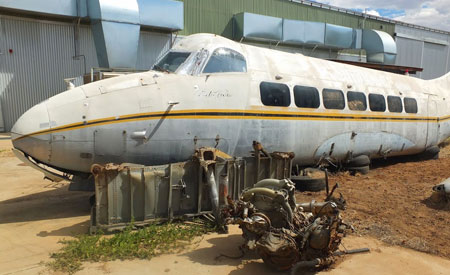 By ANDREA JOHNSTON
By ANDREA JOHNSTON
Radio 8HA & SunFM
Many people don’t realise that Alice Springs Airport didn’t always occupy its current spot, south of the Gap.
The town’s rich aviation history is celebrated at the site of its first airport on what is now Memorial Avenue.
The Central Australian Aviation Museum has recently acquired an aircraft that played a big role for the airline that was founded here in 1939, Connellan Airways, or Connair as it later became known.
The de Havilland Heron with call sign Charlie Lima Whiskey was purchased from a collector near Sydney, after flying for years in the Pacific Islands (under a different registration) following its long service in the Centre.
For former Connair pilot David Frederiksen, it’s like an “old mate” coming home.
“I did 3000 hours in Herons and a lot of it was in Charlie Lima Whiskey. You did a lot of Ayers Rock runs – sometimes two or three times a day to the Rock and back – and a lot of it was done in Charlie Lima Whiskey, so I have a close affinity with this aircraft.”
Mr Frederiksen says he once decided to get his log books out and count up the number of trips he made to the Rock. The answer was 430.
The Heron was manufactured in England, but those bought by Connellan Airways came via all sorts of locations, having done all sorts of jobs. Mr Frederiksen says two or three came from India, “but CLW came from Germany where it had been Chancellor Adenauer’s personal aeroplane”.
With such an illustrious history, it was an acquisition worth taking good care of as the Central Australian Aviation Museum’s Brian Eather explains.
“We unloaded it here and thought we wanted to make a proper display so we better think about a protective cover for it. So we started with the idea of a sail cloth, which are hugely expensive so we had to give that idea up.
 “We had some drawings done for a custom design but that was expensive too. In the end we settled on a pre-fabricated shelter and a small group of volunteers took on the task of assembling it.”
“We had some drawings done for a custom design but that was expensive too. In the end we settled on a pre-fabricated shelter and a small group of volunteers took on the task of assembling it.”
The construction of the shelter is well underway, and while history is on display, there’s living history at the museum too.
Iits president is the Grandson of Connair’s founder, EJ Connellan. With flying in Edward Connellan’s blood, he’s become the Chief Pilot for Mengel’s Heli Services, as well as teaching people how to fly gliders at the weekend.
But he holds the aviators of the past in high regard: “In those days there was still very much a pioneering spirit … but when we go flying today we take multiple satellite trackers, satellite phones. Everyone will know where we are at every minute along the journey, whereas in those days there were a lot more risks involved.
“People did land aircraft in the bush and were lost, and there are an awful lot of very interesting stories where people went back to get people who they’d left behind and limped home in a wounded aeroplane.”
But, as Mr Connellan explained the Heron is very significant in the Centre since it required great technical expertise to adapt the aircraft for use in the outback.
“The original engines in the Herons were designed to be used in Europe, and when faced with Central Australia’s conditions they really weren’t up to the task. So they had to be redesigned using lighter, more powerful Lycoming engines which ultimately gave them much greater endurance, lower fuel consumption, a lot more power, so they could handle the hotter and higher conditions.
“The interesting fact of the time was that all that expertise was available in Alice Springs, and it was quite a hub of aviation experience.”
Having brought an aircraft across the planet, to then have to convert its engine sounds like an awful lot of effort, but according to pilot David Frederiksen, it was certainly worthwhile.
“All these de Havilland aeroplanes were beautiful to fly. When you fly them every day they become like a glove nearly, an extension of your body and you can nearly fly them like a bird. It does exactly what you think you want to do, and all pilots who flew de Havilland aeroplanes will tell you the same story.”
There’s no date set on when the shelter and display will officially open, as it’s taking a huge volunteer effort to build.
[You can listen to Andrea Johnston’s radio feature on the Heron and the construction of the shelter on Friday, on Sun FM at 0900 or 8HA at 0930 or on the stations’ websites after the broadcast.]